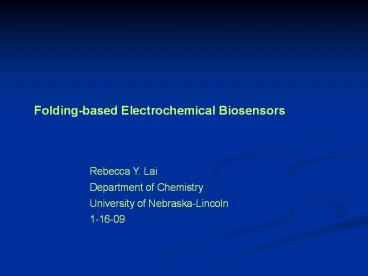Folding-based Electrochemical Biosensors - PowerPoint PPT Presentation
Title:
Folding-based Electrochemical Biosensors
Description:
Folding-based Electrochemical Biosensors Rebecca Y. Lai Department of Chemistry University of Nebraska-Lincoln 1-16-09 – PowerPoint PPT presentation
Number of Views:172
Avg rating:3.0/5.0
Title: Folding-based Electrochemical Biosensors
1
Folding-based Electrochemical Biosensors
Rebecca Y. Lai Department of Chemistry University
of Nebraska-Lincoln 1-16-09
2
Traditional Biosensor
Measure changes in adsorbed mass,
polarizability, sterics or charge
3
Folding-based Biosensors Signal Transduction
Mechanism
Signaling linked to a binding-specific change in
the physical properties of the biopolymer
4
Electrochemical Biosensors
- Low background, fewer electrochemically active
contaminants in biological systems - Low mass, volume, power
- Low cost, mass production
- Parallelization, adaptable to arraying strategies
- Example glucose meter
5
Materials and Methods
Biosensor Interrogation Method Alternating
Current Voltammetry
6
Electrochemical DNA Sensor (E-DNA)
Not to scale
5-HS-(CH2)6- GCAGTAACAAGAATAAAACGCCACTGC
-(CH2)7-NH-3-MB
7
E-DNA Sensor
AC Voltammograms
- Reagentless (direct detection of aqueous DNA)
- Sensitive (pM detection limit)
- Rapid detection
- Reusable
- Selective
- Specific
8
E-DNA Sensor
Reusable and Reproducible
9
E-DNA Sensor in a Microfluidic Chamber
In-situ sensor fabrication, hybridization and
regeneration
10
Aptamers
Aptamers are DNA or RNA molecules selected for
their ability to fold into well-defined,
three-dimensional structures and bind to specific
molecular targets (e.g. proteins, small
molecules) with high affinity.
11
Electrochemical Aptamer-Based (E-AB) SensorPDGF
Detection
- Reagentless
- Reusable
- Rapid
- Specific
- Selective
- Parallelizable
- Signal-on sensor
Not to scale
5-HS-(CH2)6- CAGGCTACGGCACGTAGAGCATCA CCATGATCCTG
-(CH2)7-NH-3-MB
12
Sensor Response to PDGF-BB
In 50 Blood Serum
13
Peptide or Protein-base Electrochemical Biosensors
Ligand-induced Folding (LIF)
Ligand-induced folding occurs when a
favorable binding free energy overcomes an
unfavorable folding free energy, producing a
folded complex.
14
Electronic Peptide-based Sensor (E-PB Sensor)
- Peptide Probes
- Naturally occurring peptide capable of LIF
- Engineered peptide capable of LIF
15
E-PB Sensor HIV Detection
Protein of Interest Surface Glycoprotein
gp120 Transmembrane Glycoprotein gp41 Matrix
Protein p17 Capsid Protein p24
16
E-PB Sensor HIV Detection
Proteins of Interest Surface Glycoprotein
gp120 Transmembrance Glycoprotein
gp41 Matrix Protein p17 Capsid Protein
p24
p17 p24 gp41 gp120
of patients for antigen 62 58 18 38
of patients positive for antibody 60 92 100 34
17
Detection of Anti p24 Antibodies
Probe
Target
Anti-p124 antibody (IgG) (150 kDa) Response in
earliest stages of AIDS Anti-p24 concentration in
serum may be tens to hundreds of nanomolar
HIV-1 p24 capsid protein Highly antigenic
epitope sequence EAAWDRVHP
18
Sensor Response to Anti-p24 Antibodies
Probe Sequence HS-C11-EAAWDRVHP-K-MB
19
Future Direction of E-PB Sensor Research
(Immediate!)
20
Future Direction of E-PB Sensor Research
Click Chemistry
Azide terminated alkanethiol alkyne modified
peptide w/ MB
- Advantages
- Flexibility in SAM choices
- Step by step characterization by
electrochemical methods and SPR - Site-specific modification/sensor fabrication
21
Future Direction of E-PB Sensor Research
- System of Interest
- HIV Detection (p24, p17, gp41, gp120)
- Biosensor Array Mixed-platform Detection
- E-PB Sensor
- E-AB Sensor
- E-DNA Sensor
- Hybrid E-PB Sensor
22
Hybrid E-PB Sensor
Peptide nucleic acid (PNA) stem Peptide loop
p24 Probe Sequence HS-C11-GAT-EAAWDRVHP-ATC-MB
23
Future Directions in Device Fabrication
Microfabricated Devices
Too Pricy and Time Consuming!
24
E-DNA Sensor on a Gold-plated Screen-printed
Carbon Electrode
25
Future Directions in Sensor Strip Fabrication
- Disposable Sensor Strip
- Pros cost effective, amenable to mass
production - Cons larger volume requirement
- (50 µL in-situ, 10 µL ex-situ)
- Future Work
- E-PB Sensor for HIV detection
- Volume reduction
- New electrode (array) design
- Enhance sensor stability (6 months shelf life)
26
Acknowledgement
University of Nebraska-Lincoln Jennifer Gerasimov
Dr. Weiwei Yang Socrates Canete Andy
Springer
UC Santa Barbara

